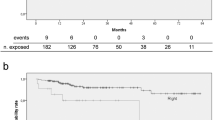Abstract
Purpose
Mechanical complications in tunneled indwelling central venous catheters (CVCs) often involve a risk of displacement. Fixation procedures are, therefore, of primary importance. We prospectively evaluated the incidence of CVC-related mechanical and infectious complications observed in devices fixated with the Sri Paran technique.
Methods
All CVCs inserted in children with cancer at our Institution from October 2005 to January 2007 were prospectively monitored for device-related mechanical and infectious complications. The Sri Paran fixation technique was used in all cases. The complication rate per 1,000 days was calculated as 1,000 times the number of complications divided by the total number of catheter days.
Results
Ninety-five CVCs were positioned in 84 children. The overall length of observation ranged between 41 and 482 days for a total of 18,618 catheter days. Mechanical complications occurred in 5% of the devices (specific rate 0.27); infections were observed in 6% of the devices (specific rate 0.32). No complications were observed during the first 30 days after CVC insertion.
Conclusions
The results, we obtained with the Sri Paran technique are extremely encouraging. Yet, randomized studies are required to prove these preliminary data.
Similar content being viewed by others
References
Eastridge BJ, Lefor AT (1995) Complications of indwelling venous access devices in cancer patients. J Clin Oncol 13:233–238
Fratino G, Mazzola C, Buffa P et al (2001) Mechanical complications related to indwelling central venous catheter in pediatric haematology/oncology patients. Pediatr Hematol Oncol 18:317–324
Journeycake JM, Buchanan GR (2003) Thrombotic complications of central venous catheters in children. Curr Opin Hematol 10(5):369–374
Mermel LA, Farr BM, Sherertz RJ et al (2001) Infectious Diseases Society of America, American College of Critical Care Medicine, Society for Healthcare Epidemiology of America. Guidelines for the management of intravascular catheter-related infections. J Intraven Nurs 24(3):180–205
Cesaro S, Corrò R, Pelosin A et al (2004) A prospective survey on incidence and outcome of Broviac/Hickman catheter-related complications in pediatric patients affected by hematological and oncological diseases. Ann Hematol 83(3):183–188
Fratino G, Castagnola E, Carlini C et al (2004) A single institution observational study of early mechanical complications in central venous catheters (valved and open-ended) in children with cancer. Pediatr Surg Int 20(9):704–707
Sri Paran T, Corbally M, Fitzgerald RI (2003) New technique for fixation of Broviac catheters. J Pediatr Surg 38(1):51–52
Fratino G, Molinari AC, Parodi S et al (2005) Central venous catheter-related complications in children with oncological/hematological diseases: an observational study of 418 devices. Ann Oncol 16(4):648–654
Racadio JM, Doellman DA, Johnson ND et al (2000) Pediatric peripherally inserted central catheters: complication rates related to catheter tip location. Pediatrics 107(2):E28
Guth AA (2001) Routine chest X-rays after insertion of implantable long-term venous catheters: necessary or not? Am Surg 67(1):26–29
Castagnola E, Molinari AC, Giacchino M et al (2007) Incidence of catheter-related infections within 30 days from insertion of Hickman–Broviac catheters. Pediatr Blood Cancer 48(1):35–38
Castagnola E, Molinari AC, Fratino G et al (2003) Conditions associated with infections of indwelling central venous catheters in cancer patients: a summary. Br J Haematol 121(2):233–239
Fratino G, Molinari AC, Mazzola C et al (2002) Prospective study of indwelling central venous catheter-related complications in children with Broviac or clampless valved catheters. J Pediatr Hematol Oncol 24(8):657–661
Shaul DB, Scheer B, Rokhsar S et al (1998) Risk factors for early infection of central venous catheters in pediatric patients. J Am Coll Surg 186(6):654–658
Boulay RM, Olt GJ, Podczaski ES (1998) Risk of venous access device wound complications in patients undergoing paclitaxel chemotherapy for gynecologic malignancies. Gynecol Oncol 70(2):259–262
Babu R, Spicer RD (2001) “Cuff-stitch” to prevent inadvertent dislodgement of central venous catheters. Pediatr Surg Int 17(2–3):245–246
Robinson JL, Tawfik G, Roth A (2005) Barriers to antibiotic lock therapy in children with intravascular catheter-related bloodstream infections. Pediatr Infect Dis J 24(10):944
Author information
Authors and Affiliations
Corresponding author
Rights and permissions
About this article
Cite this article
Fratino, G., Avanzini, S., Molinari, A.C. et al. Incidence of indwelling central venous catheter-related complications using the Sri Paran technique for device fixation in children with cancer. Pediatr Surg Int 25, 591–594 (2009). https://doi.org/10.1007/s00383-009-2400-4
Accepted:
Published:
Issue Date:
DOI: https://doi.org/10.1007/s00383-009-2400-4




